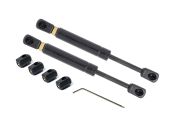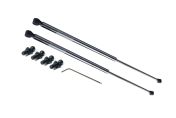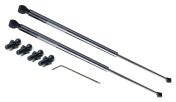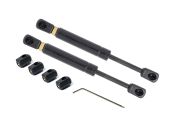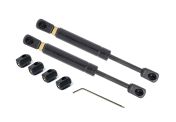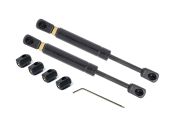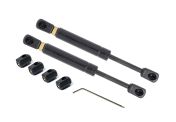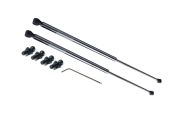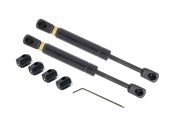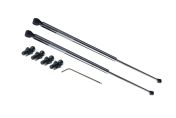Gas Struts
A gas strut, also known as a gas spring is a mechanical component that uses compressed nitrogen gas to force a precision rod attached to a piston back and forth within an enclosed metal cylinder. Gas struts are primarily designed as a direct support mechanism for safely lifting, positioning, lowering and counterbalancing different weights. For more information on how they work, you can consult our gas springs and struts guide.
How does a Gas Strut work?
A gas strut construction is very simple, it comprises of a precision rod attached to a piston and a central tubular body containing compressed nitrogen gas and lubricating oil. When force is applied to the protruding portion of the rod it presses onto the piston head a bit like a plunger on a syringe, compressing the nitrogen gas. This creates an internal pressure that exceeds the pressure outside of the cylinder closing the gas strut. When the force is removed from the external rod the gas is decompressed and the pressure pushes the piston back out again, opening the gas strut.
Types of Gas Strut
Gas struts or gas springs are available as stop and stay or variable pressure with a steel or stainless-steel body. Depending on application stroke length, extended length, minimum and maximum force ranges and end fittings must be considered.
Gas Strut sizes
- 6 mm rod diameter & 15 mm tube diameter. Range 50 to 400 N (11-90 lbs)
- 8 mm rod diameter & 18 mm tube diameter. Range 100 to 650 N (22-146 lbs)
- 10 mm rod diameter & 23 mm tube diameter. Range 150 to 1200 N (34-269 lbs)
- 14 mm rod diameter & 28 mm tube diameter. Range 200 to 2500 N (45-562 lbs)
Applications for Gas Struts
Gas struts are utilised in a wide range of applications. The most common use is for the gas spring is lifting and lowering of a car boot. Other areas include:
- Boat access hatches
- Cargo area on aeroplanes
- Office furniture and chairs
- Skylights
- Office chairs and furniture
- Machine guards and Conveyor gates
Popular Searches
Related links
- Everything You Need To Know About Gas Springs and Gas Struts
- Gas Strut End Fittings
- Camloc Steel Gas Strut 660.0mm Extended Length, 300.0mm Stroke Length
- Camloc Stainless Steel Gas Strut 240.0mm Extended Length, 100.0mm Stroke Length
- Camloc Stainless Steel Gas Strut 480.0mm Extended Length, 200.0mm Stroke Length
- Camloc Stainless Steel Gas Strut 680.0mm Extended Length, 300.0mm Stroke Length
- Camloc Stainless Steel Gas Strut 364.0mm Extended Length, 150.0mm Stroke Length
- Camloc Stainless Steel Gas Strut 160.0mm Extended Length, 60.0mm Stroke Length



